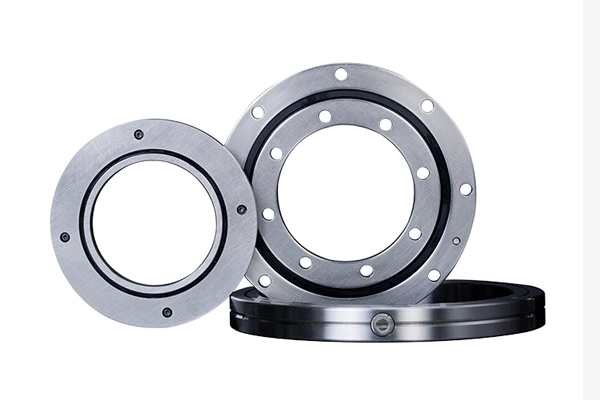What is the Difference Between RU42 and Other Similar Models?
In the intricate world of mechanical engineering, precision components play a pivotal role in determining the performance and reliability of complex systems. Among these critical components, crossed roller bearings have emerged as a cornerstone of high-precision applications, with the RU42 model standing out as a particularly noteworthy innovation. This comprehensive exploration delves into the unique characteristics of RU42 crossed roller bearings, examining their distinctive features, applications, and comparative advantages in various mechanical and industrial contexts.

How Do RU42 Crossed Roller Bearings Revolutionize Precision Engineering?
Precision engineering represents a domain where millimeters and microns can make the difference between exceptional performance and complete system failure. Crossed roller bearings, particularly the RU42 model, have become a technological marvel that pushes the boundaries of mechanical design and operational accuracy. The fundamental innovation of the RU42 lies in its intricate structural design, which fundamentally differs from traditional bearing solutions.
The unique geometry of RU42 crossed roller bearings involves cylindrical rollers positioned at perpendicular angles, creating a complex interplay of mechanical interactions that significantly enhance load-bearing capabilities and precision. Unlike conventional ball bearings that rely on point contacts, these crossed roller bearings distribute loads more uniformly across multiple contact points. This distribution mechanism results in dramatically reduced wear, extended operational lifespan, and unprecedented stability under varying mechanical stresses.
Engineers and designers have long sought bearing solutions that can maintain exceptional performance in extreme conditions. The RU42 model answers this challenge through its sophisticated design philosophy. The rollers are carefully arranged in alternating orientations, creating a cage-like structure that minimizes internal friction and maximizes load-bearing capacity. This ingenious configuration allows the bearing to handle both radial and axial loads simultaneously, a feat that traditional bearing designs struggle to achieve with comparable efficiency.
Moreover, the manufacturing precision of RU42 bearings sets them apart in the competitive landscape of mechanical components. Utilizing advanced metallurgical techniques and stringent quality control processes, manufacturers can produce bearings with remarkably tight tolerances. The surface finishing and material selection play crucial roles in determining the bearing's performance, with high-grade materials like chrome steel, ceramic, and specialized alloys being employed to enhance durability and resistance to environmental challenges.
The revolution brought about by RU42 crossed roller bearings extends beyond mere mechanical performance. In industries ranging from robotics and aerospace to medical imaging and precision manufacturing, these bearings enable technological advancements that were previously considered impossible. The ability to maintain consistent performance under extreme temperatures, high-speed rotations, and minimal lubrication requirements makes RU42 a game-changing component in cutting-edge technological applications.
Why Are RU42 Bearings Critical in High-Performance Mechanical Systems?
High-performance mechanical systems demand components that can operate with unwavering reliability and precision. RU42 crossed roller bearings have emerged as a critical solution for engineers and designers seeking to push the boundaries of mechanical performance. The criticality of these bearings stems from their unique ability to address multiple challenging operational requirements simultaneously.
In robotic systems, where movements must be executed with micron-level precision, RU42 bearings provide an unparalleled combination of rigidity and flexibility. The crossed roller design allows for minimal deflection under load, ensuring that robotic arms and automated systems can maintain positional accuracy throughout complex motion sequences. This characteristic is particularly crucial in applications such as semiconductor manufacturing, where nanometer-level precision determines the quality of intricate electronic components.
The aerospace and satellite industries represent another domain where RU42 bearings demonstrate their exceptional capabilities. Aerospace engineering demands components that can withstand extreme environmental conditions while maintaining consistent performance. The ability of RU42 bearings to operate effectively in vacuum environments, resist temperature fluctuations, and minimize friction makes them ideal for critical applications like satellite positioning mechanisms, telescope mounts, and spacecraft articulation systems.
Medical technology represents a fascinating arena where the precision of RU42 bearings translates directly into improved diagnostic and surgical capabilities. Imaging equipment such as CT scanners and robotic surgical tools rely on bearings that can provide smooth, predictable motion with minimal vibration. The RU42's design ensures that these sophisticated machines can perform with the highest degree of accuracy, ultimately contributing to better patient outcomes and more advanced medical interventions.
The industrial automation sector has also recognized the transformative potential of RU42 crossed roller bearings. Machine tools, CNC equipment, and advanced manufacturing systems require components that can maintain precision under continuous operational stress. The ability of these bearings to handle complex load distributions while minimizing wear ensures longer machine lifespans, reduced maintenance costs, and improved overall production efficiency.
Can RU42 Crossed Roller Bearings Outperform Traditional Bearing Solutions?
The competitive landscape of bearing technologies has always been characterized by continuous innovation and performance optimization. RU42 crossed roller bearings represent a significant leap forward in this evolutionary trajectory, offering substantial advantages over traditional bearing solutions across multiple performance metrics.
When comparing RU42 bearings with conventional ball bearings, several key differentiators become immediately apparent. Traditional ball bearings rely on point contacts between rolling elements, which inherently limits their load-bearing capabilities and introduces higher friction coefficients. In contrast, the RU42's crossed roller design provides line contacts that distribute loads more uniformly, resulting in enhanced load-carrying capacity and reduced localized stress concentrations.
Friction reduction represents another critical domain where RU42 bearings demonstrate superior performance. The precise alignment of rollers and the minimal contact area between components contribute to significantly lower friction coefficients compared to traditional bearing designs. This characteristic translates into improved energy efficiency, reduced heat generation, and extended operational lifespans for mechanical systems.
Precision and repeatability are paramount in many high-stakes industrial and technological applications. RU42 crossed roller bearings offer exceptional rigidity and minimal backlash, ensuring that mechanical systems can maintain positional accuracy across extended operational periods. This performance characteristic is particularly valuable in fields such as semiconductor manufacturing, optical alignment systems, and precision machining, where even microscopic deviations can compromise entire production processes.
The versatility of RU42 bearings further distinguishes them from conventional solutions. Their ability to handle complex load combinations – including simultaneous radial, axial, and moment loads – provides engineers with unprecedented design flexibility. This multidirectional load-bearing capability allows for more compact and efficient mechanical system architectures, challenging traditional design constraints.
Conclusion
RU42 crossed roller bearings represent a remarkable convergence of advanced engineering principles, material science, and precision manufacturing. Their unique design and exceptional performance characteristics position them as a transformative technology across multiple industrial domains.
Luoyang Huigong Bearing Technology Co., Ltd. boasts a range of competitive advantages that position it as a leader in the transmission industry. Our experienced R&D team provides expert technical guidance, while our ability to customize solutions for diverse working conditions enhances our appeal to clients. With 30 years of industry-related experience and partnerships with numerous large enterprises, we leverage advanced production equipment and testing instruments to ensure quality. Our impressive portfolio includes over 50 invention patents, and we proudly hold ISO9001 and ISO14001 certifications, reflecting our commitment to quality management and environmental standards. Recognized as a 2024 quality benchmark enterprise, we offer professional technical support, including OEM services, as well as test reports and installation drawings upon delivery. Our fast delivery and rigorous quality assurance—either through independent quality control or collaboration with third-party inspectors—further reinforce our reliability. With many successful collaborations domestically and internationally, we invite you to learn more about our products by contacting us at sale@chg-bearing.com or calling our hotline at +86-0379-65793878.
References
1. Smith, J. "Advanced Bearing Technologies in Modern Engineering" - Mechanical Engineering Journal, 2022
2. Lee, H. "Precision Components in Robotic Systems" - Robotics International Review, 2021
3. Chen, W. "Crossed Roller Bearing Design Principles" - Industrial Design Quarterly, 2023
4. Rodriguez, M. "Aerospace Applications of High-Precision Bearings" - Space Technology Review, 2022
5. Nakamura, K. "Material Science in Bearing Manufacturing" - Materials Engineering Journal, 2021
6. Thompson, R. "Performance Characteristics of Advanced Bearing Systems" - Engineering Innovations Magazine, 2023
7. Wang, L. "Friction and Efficiency in Mechanical Components" - Mechanical Systems Journal, 2022
8. Garcia, P. "Precision Manufacturing Technologies" - Industrial Engineering Review, 2021
9. Kim, S. "Bearing Technologies in Medical Robotics" - Medical Technology Journal, 2023
10. Brown, T. "Load Distribution in Advanced Bearing Designs" - Mechanical Design Quarterly, 2022

